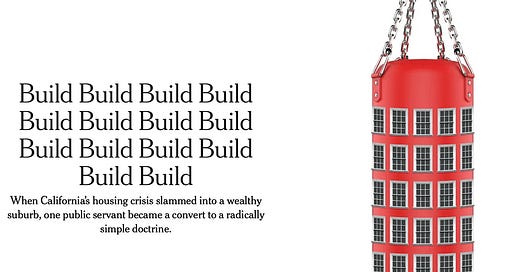

Discover more from Fresh Economic Thinking
Property cartel goes mainstream
Even writers at the New York Times are noticing that property developers won't flood the market to bring down prices.
For years I’ve been trying to explain that the property market has a built-in speed limit on how fast it produces new housing.
Now others, like Conor Dougherty at the New York Times, are noticing. He wrote the following a few weeks back.
The United States has a deep, decades-old housing shortage. Also, at the moment, homebuilders across the country are pulling back on development because they can’t sell enough homes.
How can both of these things be true?
Despite dwelling prices still being near record highs, property developers have suddenly decided to stop producing.
That’s a puzzle if you subscribe to the idea that developers want to supply at a rate that is high enough to depress prices.
If you don’t subscribe to that idea, and instead have a good grasp of the theory of the market absorption rate because you’ve read my paper on it, then it is no puzzle at all.
In the absorption rate theory, price levels don’t determine supply. But the rate of growth in demand (how fast the demand curve for buying property shifts vertically) does. When demand falls, you stop supplying. Simple and predictable. After all, property owners are in the business of making money, not making housing cheap by flooding the market.
There are two comments I want to make about this article. First, I want to comment on how effective the property lobby has been in fostering the planning has caused a housing shortage story. Second, I note how economic theory is used as a weapon, not as a basis for understanding.


The property lobby is good at their job
It was quite a surprise to see Randall Lewis, self-confessed landbanker and speculator, in that article talking about housing supply.
“This is going to have a significant impact on future supply,” said Randall Lewis, a principal at the family-owned Lewis Group of Companies, a developer of master planned communities in California and Nevada. Mr. Lewis’s company takes raw land and over the course of decades adds basic infrastructure like sewers, streets and traffic signals. When companies like his pull back, the number of lots homebuilders can use in the future declines.
“We are now saying we’re going to look project by project and say which ones are we are going to go ahead on and which we are going to take a pause on,” he said. “As a developer, the question is, how much money do you want to put in the dirt when you don’t know what the future is going to hold?”
(my emphasis)
Let’s not forget that Randall Lewis sponsors the UCLA Lewis Center to produce research that protects the value of his interests by blaming planning for its role in reducing the rate of new supply.
Yet here is is saying he can develop housing faster but won’t do it if it depresses prices.
This quote also reminds me that one of the subtle ways the property lobby has manipulated the housing supply debate is by repeating the claim that builders choose how many homes to build. But builders can’t just build homes whenever they like. Only property owners can decide to subdivide. Only property owners can decide to build.
Builders are paid by property owners who choose how many new dwellings to build on their property.
Here’s an example of how the roles of building and developing get confused, by first saying that it’s all about builders adjusting to demand, then quietly noting the role of developers without ever being clear that they are the decision makers.
The slowdown in homebuilding wouldn’t have such a significant effect on the nation’s overall housing supply if builders could quickly adjust to demand, making up for the recessionary shortages during boom times. But they can’t: Housing is a hugely fragmented industry of mostly independent companies that includes developers that spend decades turning raw land into parcels that can be built upon and subcontractors that hire laborers by the hour. The system works fine when demand is strong, but deteriorates with even a modest sign of trouble and can take years to restart, creating a backlog that gets deeper each time building slows.
This quote is also strangely contradictory. It says that in a boom (demand is strong) there are many constraints, but also the system “works fine”. But when there is a bust (demand is weak) there are no constraints, but the system does not work fine.
A very strange argument.
The thing is, builders can quickly respond to demand for their construction services from property owners. There are a record number of homes under construction in the United States as of mid-2022, and the industry as a whole is able to increase dwelling construction by a factor of 4x over the business cycle.
If planning is constraining the rate of new housing development, how does it also allow the rate of supply to increase by 4x when property owners decide to build?
Where theory goes to die
What astounds me is that in Dougherty’s NYT article, Economics 101 apparently now says the opposite of what it said just two years ago.
Developers are responding the way Economics 101 says they should: by cutting prices on the houses they have already built, and by pulling the plug on virtually any project that wasn’t already too far along to be abandoned. Builders started construction on about 93,000 single-family homes in June, down 16 percent from a year earlier.
“Very smartly, builders are saying hey, let’s rein it in,” said Rick Palacios Jr., director of research for John Burns Real Estate Consulting. “Yes, we are undersupplied from a structural standpoint, but when rates roughly double in the space of three or four months, builders don’t care. They are planning their business for the now.” Some have puzzled over the idea that a price ceiling.
But just two years ago, the same NYT author was writing about how local politics was the main issue that determined the rate of new housing in the country. The Economics 101 argument I have been arguing against for years is that local NIMBYs restrict supply and this increases prices.
Perhaps it is property owners who choose the rate of new supply at all points in the business cycle? Sure, local politics might change where different types of new dwellings are built, but that doesn’t necessarily change the overall rate of new housing construction.
Read more
I have a bunch of papers about the housing market generally, and the rate of new housing supply, known as the absorption rate, specifically.
A housing supply absorption rate equation (free version, published version)
Time is money: How landbanking constrains housing supply (free, published)
We zoned for density and got higher house prices: Supply and price effects of upzoning over 20 years (free)
When homes earn more than jobs: the rentierization of the Australian housing market (free and published)











Two facts should slap you in the face when you see the supposed puzzle of housing shortages alongside slowing development.
First, like you say, that developers have no incentive to eat their own profit.
Second, that the problem is fundamentally one of income distribution, not housing market policy. If people (e.g. the homeless) need homes, and developers don't want to build them, it can only be because those people lack the purchasing power to draw those resources into use.
Nice clean example: NZ. The lowest disposable incomes here (for a single beneficiary) are $16,000 per annum. Housing affordability at the 30% benchmark would mean these people spend $5,000 on rent. That amount could service a $100,000 mortgage for the landlord. Which is about half what is needed to construct the cheapest unit imaginable, assuming free land. Even a full-time minimum wage earner has only $32,000 disposable, barely enough at the 30% benchmark to finance construction of the cheapest home.
If people aren't earning enough to finance the bricks and mortar (let alone land acquisition) for the cheapest housing possible then no housing market policy settings can fix that. If the problem can't be fixed in the housing market, but can be fixed by redistribution, it's an inequality problem, not a housing problem.
I suppose it makes for sexier careers and better headlines to pretend it's all about housing.
And it's certainly a nice bait-and-switch to blame the results of the neoliberal revolution on the neoliberal revolution not going far enough.
I think the main way in which planning decision-making, which itself is affected by the 'Nimby' syndrome, affects the economics and viability of housing supply, and potentially the quantum of housing supplied, is by increasing costs and risks associated with projects.
For example, if you have fewer parcels of land that are planned for a particle type of housing that is in demand then developer's may end up paying more for those parcels due to greater competition in the market, i.e. ultimately developers need land to have projects and a business. Project delays due to planning decision-making also increase costs, e.g. holding costs for the land and costs for development consultants needed to navigate through the planning system.
Infrastructure costs are also big factor in both the viability of individual projects and in the real availability of land for development, i.e. high infrastructure headworks costs constrain the real availability of land for development and hence the level of competition for the available land, increasing the costs of acquisition.